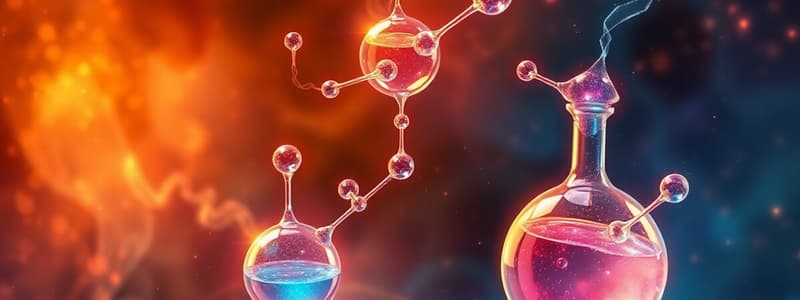Podcast
Questions and Answers
Which piece of evidence supports the resonance structure of arenes?
Which piece of evidence supports the resonance structure of arenes?
- There are multiple isomers of 1,2-dichlorobenzene.
- Arenes undergo hydration reactions like alkenes.
- All arene C-C bonds are equal in length at 140 pm. (correct)
- All arene C-C bonds have different lengths.
Why do arenes not undergo certain reactions that alkenes do?
Why do arenes not undergo certain reactions that alkenes do?
- The presence of a benzene ring stabilizes the structure. (correct)
- They easily undergo hydrogenation reactions.
- They are electron-deficient molecules.
- They lack sufficient energy to break C-H bonds.
What is a correct product of the electrophilic substitution reaction involving benzene?
What is a correct product of the electrophilic substitution reaction involving benzene?
- Electrophile replaces a hydrogen atom to form a substituted benzene. (correct)
- Formation of C=C bonds.
- Arene undergoes complete combustion.
- Hydration of benzene to form phenol.
What characteristic of arenes is reflected in their lower than expected energy release during hydrogenation?
What characteristic of arenes is reflected in their lower than expected energy release during hydrogenation?
Which reaction condition is typically needed to initiate electrophilic substitution in arenes?
Which reaction condition is typically needed to initiate electrophilic substitution in arenes?
Which of the following best describes the high activation energy (Ea) in the reaction mechanism of arenes?
Which of the following best describes the high activation energy (Ea) in the reaction mechanism of arenes?
What is the expected energy release when hydrogenating benzene compared to alkenes?
What is the expected energy release when hydrogenating benzene compared to alkenes?
Which of the following molecules is classified as an arene?
Which of the following molecules is classified as an arene?
Flashcards
Bond Length of Benzene
Bond Length of Benzene
The observation that all C-C bonds in benzene are the same length, at 140 pm, providing evidence for delocalization of electrons.
Non-Reacting with Alkene Reagents
Non-Reacting with Alkene Reagents
The fact that benzene does not react with typical alkene reagents, like H2O or Br2, under normal conditions, indicates it is more stable and does not behave like a typical alkene.
Heat of Hydrogenation of Benzene
Heat of Hydrogenation of Benzene
The observation that the heat of hydrogenation of benzene is less than expected, indicating that the ring is more stable than the hypothetical alternating double bond model would predict. (Theoretical -360 kJ mol-1, Actual -208 kJ mol-1).
Two Isomers of 1,2-Dichlorobenzene?
Two Isomers of 1,2-Dichlorobenzene?
Signup and view all the flashcards
What are Arene?
What are Arene?
Signup and view all the flashcards
Electrophilic Substitution
Electrophilic Substitution
Signup and view all the flashcards
High Activation Energy in Arenes
High Activation Energy in Arenes
Signup and view all the flashcards
Positively Charged Intermediate
Positively Charged Intermediate
Signup and view all the flashcards
Study Notes
Arene Resonance
- Arenes, despite being depicted with alternating single and double bonds, are better described using resonance structures.
- If alternating single and double bonds truly existed, there'd be two isomers of a molecule like 1,2-dichlorobenzene with different properties. However, this is not observed.
- All C-C bonds in an arene have the same length (140 pm), whereas single C-C bonds are 154 pm, and double bonds are 134 pm.
Arene Reactions
- Arenes do not undergo reactions (like hydration, hydrogenation, halogenation) that alkenes do under the same conditions.
- Less energy is released during the hydrogenation of an arene compared to the expected value. Hydrogenating three C=C bonds should release -360 kJ mol⁻¹, but it only releases -208 kJ mol⁻¹ for benzene. This lower energy suggests arenes are surprisingly stable.
Electrophilic Substitution
- Benzene and substituted benzene rings (arenes) undergo electrophilic substitution.
- Benzene is electron-rich.
- An electrophile (electron-loving species) attacks the benzene ring.
- A C–H bond on the ring gets replaced with a C–E bond.
Electrophilic Substitution Mechanism
- To react, the delocalized electrons in the arene ring must be disrupted.
- A positively charged intermediate is formed.
- The hydrogen bonded to the same carbon as the electrophile leaves.
- Resonance is restored.
- The process of breaking resonance is the slow step.
Electrophilic Substitution: Halogenation
- Reactants: Benzene (arene), Cl₂ (Chlorine), FeCl₃ (iron(III) chloride)
- Catalyst: FeCl₃ - creates a chlorine electrophile
- Conditions: Dry ether
- Product: Chlorobenzene, HCl.
Electrophilic Substitution: Nitration of Benzene
- Reactants: Benzene (arene), HNO₃ (Nitric acid), H₂SO₄ (Sulfuric acid)
- Catalyst: H₂SO₄ - creates a nitrate electrophile
- Conditions: 50° C
- Product: Nitrobenzene, H₂O
General Organic Reactions (Diagram)
- The diagram shows various organic reactions and their transformations.
- It includes conversions between alkanes, alkenes, alcohols, ketones, aldehydes, and carboxylic acids using a range of reagents, catalysts, conditions for each reaction.
- The provided diagram needs further clarification to be usable for notes.
Organic Synthesis (Reactions)
- A series of chemical reactions involving the construction of more complex molecules from simpler ones.
Studying That Suits You
Use AI to generate personalized quizzes and flashcards to suit your learning preferences.




